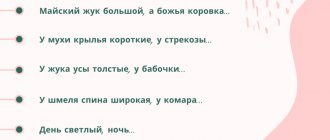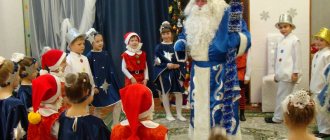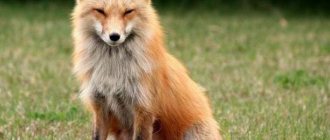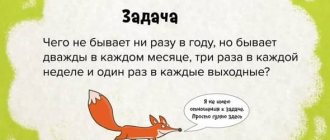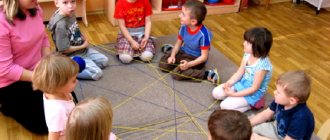Goals and objectives of finger gymnastics
Finger gymnastics is useful for a child at any age. Children perceive such activities as a fun game. However, classes have goals, namely:
- Fine motor skills of fingers. For children in nursery groups, starting from 3-4 years old, finger games are introduced into the compulsory educational program. This develops the flexibility of the hand and fingers, which is necessary for further learning of writing skills. Children with developed finger motor skills have neat handwriting and it is easier for them to learn how to handle school objects, for example, a ruler and compass.
- Attention. Due to the fact that the lesson is accompanied by game elements, the child’s attention is maximally concentrated on the lesson. Thus, from a young age, children learn to listen carefully and repeat. This skill will also be useful to them in school.
- Speech. The centers responsible for fine motor skills and the speech apparatus are located nearby in the brain and are interconnected. If there are problems with speaking, finger exercises help children in the younger group learn to speak faster and form sentences.
- Imagination. Any finger games are essentially a mini-performance involving a child. During the exercise, the child projects in his imagination a picture from the story itself. This helps develop his creativity and imagination.
- Memory. In elementary and preschool age, finger gymnastics is useful because constant repetition of exercises promotes rapid memorization and memory development. This will help you remember new information better at school.
Recommendations for performing exercises
Regularity is the most important condition for finger exercises to produce positive results. In order for the child to perform the exercise with interest, it is recommended to reduce the duration of classes to 5 minutes.
During finger gymnastics, children's attention should be focused directly on the exercises themselves, so it is better not to do them immediately after outdoor games.
Young children like to repeat after adults and during such repeated repetitions their mental and physical memory works. That is why finger games are recommended for the mental, physical and emotional development of a child.
Finger games
There are many options for classes of varying difficulty. Finger games in nursery groups are distinguished by the simplest actions and short rhymes to make it easier to remember and repeat.
In the younger group
These exercises are recommended for children 3-4 years old.
Bug
Purpose: A short warm-up to get kids to repeat certain actions and words after adults.
I'm a big funny bug. I know what is growing around me. I circle over the gardens, and my name is Zhu-Zhu. (they wave their clenched fist in the air, imitating the flight of a beetle) I also spend hours wiggling my mustache. (extend index finger and little finger, move fingers like a beetle’s mustache)
Bee
Purpose: Develops memory and concentration, helps to learn the name of insects.
One striped bee flew to us, (children wave their palms) Together with her, a bumblebee and a beautiful moth, two beetles, a dragonfly. (they bend their fingers one by one, show a dragonfly, putting two circles made from the index and thumb to their eyes) They all buzzed, flew in the air, (flapping their palms like wings) And then they got tired, took it and fell. (hands are placed on the table)
How to do it: At the first phrase about a bee, children wave their palms. When they begin to list the remaining insects, they bend one finger at a time. In the phrase about the dragonfly, make circles from the index and thumb and apply them to the eyes. Then they wave their palms, and at the end of the exercise they place their hands on the table.
Centipede
Purpose: A playful, fun exercise with a short rhyme to practice fine motor skills.
Here is a centipede running across Alyoshka’s palm. Her legs tickle so much that our Alyoshka laughs. (fingers tickle the palm from the tips to the base, and then in the other direction)
Use pictures on the theme “Insects” for children for finger games
In the middle group
For children 4-5 years old studying in the middle group, the tasks are made more difficult.
Mosquito
Purpose: A short game session to develop memory and attention.
A fly flies near the ear, wasps fly near the nose. (twirl the index finger near the ear, then near the nose) A mosquito is flying and lands on your forehead! (put a finger on the forehead) We hit him - clap! They brought it to their ear. (cover their forehead with their palm, press their fist to their ear) Let’s take it and let it go? Let's go! (open fist and blow on it)
Ladybug
Purpose: The exercise is aimed at ensuring that the child remembers the sequence of actions and stimulates finger motor skills.
Ladybug's dad is walking, (“walking” with the fingers of his left hand) Dad is following mom. (further with the right hand) The kids follow their mother, (now they “walk” with both hands) The little ones wander after them. (palms pressed together) They wear red suits, Suits with black dots. (knock on the table with their index fingers) Dad takes the family to kindergarten and takes them home after classes. (“walk” with both hands)
Ant
Goal: To develop finger motor skills and observation skills in a child.
There is a little house on a hill, (they fold their hands into a “house”) and an ant is crawling into it. (with their fingers they show how an ant crawls) He drags straws and chips there so that the house is strong. (hands fold into a “lock”) Around the house are his brothers - Diligent ants. (they show the ant crawling again) They bring a worm, a bug, a spider and a bug to the anthill house. (they show the worm with their index finger) Who builds, who feeds the Kids - little ants. This is how their day passes at work, in labor and care. (they hit each other with their fists)
